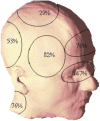Chronic post-traumatic headache: clinical findings and possible mechanisms
- PMID: 24976746
- PMCID: PMC4062350
- DOI: 10.1179/2042618613Y.0000000053
Chronic post-traumatic headache: clinical findings and possible mechanisms
Abstract
Chronic post-traumatic headache (CPTHA), the most frequent complaint after traumatic brain injury (TBI), dramatically affects quality of life and function. Despite its high prevalence and persistence, the mechanism of CPTHA is poorly understood. This literature review aimed to analyze the results of studies assessing the characteristics and sensory profile of CPTHA in order to shed light on its possible underlying mechanisms. The search for English language articles published between 1960 and 2013 was conducted in MEDLINE, CINAHL, and PubMed. Studies assessing clinical features of headache after TBI as well as studies conducting quantitative somatosensory testing (QST) in individuals with CPTHA and in individuals suffering from other types of pain were included. Studies on animal models of pain following damage to peripheral tissues and to the peripheral and central nervous system were also included. The clinical features of CPTHA resembled those of primary headache, especially tension-type and migraine headache. Positive and negative signs were prevalent among individuals with CPTHA, in both the head and in other body regions, suggesting the presence of local (cranial) mechanical hypersensitivity, together with generalized thermal hypoesthesia and hypoalgesia. Evidence of dysfunctional pain modulation was also observed. Chronic post-traumatic headache can result from damage to intra- and pericranial tissues that caused chronic sensitization of these tissues. Alternatively, although not mutually exclusive, CPTHA might possibly be a form of central pain due to damage to brain structures involved in pain processing. These, other possibilities, as well as risk factors for CPTHA are discussed at length.
Keywords: Chronic pain; Headache; Mechanisms; Traumatic brain injury.
Figures
References
-
- Faul M, Xu L, Wald MM, Coronado VG. Traumatic brain injury in the United States: emergency department visits, hospitalization and deaths 2002–2006. Atlanta, GA: Centers for Disease Control and Prevention, National Center for Injury Prevention and Control; 2010.
-
- Uomoto JM, Esselman PC. Traumatic brain injury and chronic pain: differential types and rates by head injury severity. Arch Phys Med Rehabil. 1993;74:61–4. - PubMed
-
- Beetar JT, Guilmette TJ, Sparadeo FR. Sleep and pain complaints in symptomatic traumatic brain injury and neurological populations. Arch Phys Med Rehabil. 1996;77:1298–302. - PubMed
-
- Lahz S, Bryant RA. Incidence of chronic pain following traumatic brain injury. Arch Phys Med Rehabil. 1996;77:889–91. - PubMed
-
- Nampiaparampil DE. Prevalence of chronic pain after traumatic brain injury: a systematic review. JAMA. 2000;300:711–9. - PubMed
LinkOut - more resources
Full Text Sources
Other Literature Sources
Medical


